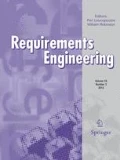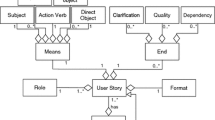Abstract
Defects in requirement specifications can have severe consequences during the software development life cycle. Some of them may result in poor product quality and/or time and budget overrun due to incorrect or missing quality characteristics, such as security. This characteristic requires special attention in web applications because they have become a target for manipulating sensible data. Several concerns make security difficult to deal with. For instance, security requirements are often misunderstood and improperly specified due to lack of security expertise and emphasis on security during early stages of software development. This often leads to unspecified or ill-defined security-related aspects. These concerns become even more challenging in agile contexts, where lightweight documentation is typically produced. To tackle this problem, we designed an approach for reviewing security-related aspects in agile requirements specifications of web applications. Our proposal considers user stories and security specifications as inputs and relates those user stories to security properties via natural language processing. Based on the related security properties, our approach identifies high-level security requirements from the Open Web Application Security Project (OWASP) to be verified and generates a reading technique to support reviewers in detecting defects. We evaluate our approach via three experimental trials conducted with 56 novice software engineers, measuring effectiveness, efficiency, usefulness and ease of use. We compare our approach against using: (1) the OWASP high-level security requirements and (2) a perspective-based approach as proposed in contemporary state of the art. The results strengthen our confidence that using our approach has a positive impact (with large effect size) on the performance of inspectors in terms of effectiveness and efficiency.












Similar content being viewed by others
References
Alsaqaf W, Daneva M, Wieringa R (2017) Quality requirements in large-scale distributed agile projects–a systematic literature review. In: International working conference on requirements engineering: foundation for software quality, pp 219–234. Springer, Berlin
Araujo R, Curphey M (2005) Software security code review: code inspection finds problems. Software Magazine. July 2005
Azuma M (2001) Square: the next generation of the ISO/IEC 9126 and 14598 international standards series on software product quality. In: ESCOM (European software control and metrics conference), pp 337–346. Springer, Berlin
Basili V, Caldiera G, Lanubile F, Shull F (1996) Studies on reading techniques. In: Proceedings of the twenty-first annual software engineering workshop, vol 96, p 002. Citeseer
Basili VR (1992) Software modeling and measurement: the goal/question/metric paradigm. Tech. rep
Beck K, Beedle M, Van Bennekum A, Cockburn A, Cunningham W, Fowler M, Grenning J, Highsmith J, Hunt A, Jeffries R et al (2001) Manifesto for agile software development. http://agilemanifesto.org. Accessed 21 Aug 2020
Bjarnason E, Runeson P, Borg M, Unterkalmsteiner M, Engström E, Regnell B, Sabaliauskaite G, Loconsole A, Gorschek T, Feldt R (2014) Challenges and practices in aligning requirements with verification and validation: a case study of six companies. Empir Softw Eng 19(6):1809–1855
Boehm B (2002) Get ready for agile methods, with care. Computer 1:64–69
Boehm B, Basili VR (2005) Software defect reduction top 10 list. Foundations of empirical software engineering: the legacy of Victor R. Basili 426(37):426–431
Cao L, Ramesh B (2008) Agile requirements engineering practices: an empirical study. IEEE Softw 25(1):60–67
Carver JC (2010) Towards reporting guidelines for experimental replications: A proposal. In: 1st international workshop on replication in empirical software engineering, pp 2–5. Citeseer
Carver JC, Shull F, Rus I (2006) Finding and fixing problems early: a perspective-based approach to requirements and design inspections. STSC CrossTalk
Chung L, Nixon BA, Yu E, Mylopoulos J (2012) Non-functional requirements in software engineering, vol 5. Springer, Berlin
Daneva M, Wang C (2018) Security requirements engineering in the agile era: how does it work in practice? In: 2018 IEEE 1st international workshop on quality requirements in agile projects (QuaRAP), pp 10–13. IEEE
Davis FD (1989) Perceived usefulness, perceived ease of use, and user acceptance of information technology. MIS quarterly, pp 319–340
Deepa G, Thilagam PS (2016) Securing web applications from injection and logic vulnerabilities: approaches and challenges. Inf Softw Technol 74:160–180
Devanbu PT, Stubblebine S (2000) Software engineering for security: a roadmap. In: Proceedings of the conference on the future of software engineering, pp 227–239. ACM, Cambridge
Domah D, Mitropoulos FJ (2015) The nerv methodology: a lightweight process for addressing non-functional requirements in agile software development. In: SoutheastCon 2015, pp 1–7. IEEE
Eberlein A, Leite J (2002) Agile requirements definition: a view from requirements engineering. In: Proceedings of the international workshop on time-constrained requirements engineering (TCRE’02), pp 4–8
Elberzhager F, Klaus A, Jawurek M (2009) Software inspections using guided checklists to ensure security goals. In: 2009 international conference on availability, reliability and security, pp 853–858. IEEE
Fabian B, Gürses S, Heisel M, Santen T, Schmidt H (2010) A comparison of security requirements engineering methods. Requir Eng 15(1):7–40
Falessi D, Juristo N, Wohlin C, Turhan B, Münch J, Jedlitschka A, Oivo M (2018) Empirical software engineering experts on the use of students and professionals in experiments. Empir Softw Eng 23(1):452–489
Fernández DM, Wagner S, Kalinowski M, Felderer M, Mafra P, Vetrò A, Conte T, Christiansson MT, Greer D, Lassenius C et al (2017) Naming the pain in requirements engineering. Empir Softw Eng 22(5):2298–2338
Fernández DM, Wagner S, Kalinowski M, Schekelmann A, Tuzcu A, Conte T, Spinola R, Prikladnicki R (2015) Naming the pain in requirements engineering: comparing practices in brazil and germany. IEEE Softw 32(5):16–23
FoxBusiness.com: Biggest cyber attacks in history. Yahoo Finance. https://finance.yahoo.com/news/worst-cyber-attacks-past-10-202226243.html . Accessed 21 Aug 2020
Goertzel KM, Winograd T, McKinley HL, Oh LJ, Colon M, McGibbon T, Fedchak E, Vienneau R (2007) Software security assurance: a state-of-art report (sar). Tech. rep., Information assurance technology analysis center (IATAC)
Haley C, Laney R, Moffett J, Nuseibeh B (2008) Security requirements engineering: a framework for representation and analysis. IEEE Trans Softw Eng 34(1):133–153
Halling M, Biffl S, Grechenig T, Kohle M (2001) Using reading techniques to focus inspection performance. In: Proceedings 27th EUROMICRO conference. 2001: a net odyssey, pp 248–257. IEEE
Houmb SH, Islam S, Knauss E, Jürjens J, Schneider K (2010) Eliciting security requirements and tracing them to design: an integration of common criteria, heuristics, and umlsec. Requir Eng 15(1):63–93
Howard M, Lipner S (2006) The security development lifecycle, vol 8. Microsoft Press, Redmond
Inayat I, Salim SS, Marczak S, Daneva M, Shamshirband S (2015) A systematic literature review on agile requirements engineering practices and challenges. Comput Hum Behav 51:915–929
Kraut RE, Streeter LA (1995) Coordination in software development. Commun ACM 38(3):69–82
Kuhrmann M, Diebold P, Münch J, Tell P, Garousi V, Felderer M, Trektere K, McCaffery F, Linssen O, Hanser E et al (2017) Hybrid software and system development in practice: waterfall, scrum, and beyond. In: Proceedings of the 2017 international conference on software and system process, pp 30–39. ACM
Lami G, Gnesi S, Fabbrini F, Fusani M, Trentanni G (2004) An automatic tool for the analysis of natural language requirements. Informe técnico, CNR Information Science and Technology Institute, Pisa, Italia, Setiembre
Lucassen G, Dalpiaz F, van der Werf JME, Brinkkemper S (2015) Forging high-quality user stories: towards a discipline for agile requirements. In: 2015 IEEE 23rd international requirements engineering conference (RE), pp 126–135. IEEE
McGraw G (2006) Software security: building security, vol 1. Addison-Wesley Professional, Cambridge
Mead NR, Stehney T (2005) Security quality requirements engineering (SQUARE) methodology, vol 30. ACM, Cambridge
Mellado D, Blanco C, Sánchez LE, Fernández-Medina E (2010) A systematic review of security requirements engineering. Comput Stand Interfaces 32(4):153–165
Mellado D, Fernández-Medina E, Piattini M (2007) A common criteria based security requirements engineering process for the development of secure information systems. Computer standards & interfaces 29(2):244–253
Nerur S, Mahapatra R, Mangalaraj G (2005) Challenges of migrating to agile methodologies. Commun ACM 48(5):72–78
Nuseibeh B, Easterbrook S (2000) Requirements engineering: a roadmap. In: Proceedings of the conference on the future of software engineering, pp 35–46. ACM
OWASP: The Open Web Application Security Project. https://owasp.org. Accessed 21 Aug 2020
Peine H, Jawurek M, Mandel S (2008) Security goal indicator trees: A model of software features that supports efficient security inspection. In: 2008 11th IEEE high assurance systems engineering symposium, pp 9–18. IEEE
Penzenstadler B, Raturi A, Richardson D, Tomlinson B (2014) Safety, security, now sustainability: the nonfunctional requirement for the 21st century. IEEE Softw 31(3):40–47
Ramesh B, Cao L, Baskerville R (2010) Agile requirements engineering practices and challenges: an empirical study. Inform Syst J 20(5):449–480
Riaz M, King J, Slankas J, Williams L (2014) Hidden in plain sight: automatically identifying security requirements from natural language artifacts. In: 2014 IEEE 22nd international requirements engineering conference (RE), pp 183–192. IEEE
Sampaio L, Garcia A (2016) Exploring context-sensitive data flow analysis for early vulnerability detection. J Syst Softw 113:337–361. https://doi.org/10.1016/j.jss.2015.12.021
Schön EM, Thomaschewski J, Escalona MJ (2017) Agile requirements engineering: a systematic literature review. Comput Stand Interfaces 49:79–91
Shull FJ, Basili VR (1998) Developing techniques for using software documents: a series of empirical studies. Ph.D. thesis, research directed by Dept. of Computer Science. University of Maryland
Slankas J, Williams L (2013) Automated extraction of non-functional requirements in available documentation. In: 2013 1st International workshop on natural language analysis in software engineering (NaturaLiSE), pp 9–16. IEEE
Subashini S, Kavitha V (2011) A survey on security issues in service delivery models of cloud computing. J Netw Comput Appl 34(1):1–11
Terpstra E, Daneva M, Wang C (2017) Agile practitioners’ understanding of security requirements: insights from a grounded theory analysis. In: 2017 IEEE 25th International Requirements Engineering Conference Workshops (REW), pp. 439–442. IEEE
Travassos G, Shull F, Fredericks M, Basili VR (1999) Detecting defects in object-oriented designs: using reading techniques to increase software quality. In: ACM Sigplan notices, vol 34, pp 47–56. ACM
Turner M, Kitchenham B, Brereton P, Charters S, Budgen D (2010) Does the technology acceptance model predict actual use? a systematic literature review. Inf Softw Technol 52(5):463–479
VanVoorhis CW, Morgan BL (2007) Understanding power and rules of thumb for determining sample sizes. Tutor Quant Methods Psychol 3(2):43–50
Villamizar H, Kalinowski M, Viana M, Fernández DM (2018) A systematic mapping study on security in agile requirements engineering. In: 2018 44th Euromicro conference on software engineering and advanced applications (SEAA), pp 454–461. IEEE
Villamizar H, Neto AA, Kalinowski M, Garcia A, Méndez D (2019) An approach for reviewing security-related aspects in agile requirements specifications of web applications. In: 2019 IEEE 27th international requirements engineering conference (RE), pp 86–97. IEEE
Wohlin C, Runeson P, Höst M, Ohlsson MC, Regnell B, Wesslén A (2012) Experimentation in software engineering. Springer, Berlin
Zubrow D (2004) Software quality requirements and evaluation, the iso 25000 series. Software Engineering Institute, Carnegie Mellon
Author information
Authors and Affiliations
Corresponding author
Additional information
Publisher's Note
Springer Nature remains neutral with regard to jurisdictional claims in published maps and institutional affiliations.
Rights and permissions
About this article
Cite this article
Villamizar, H., Kalinowski, M., Garcia, A. et al. An efficient approach for reviewing security-related aspects in agile requirements specifications of web applications. Requirements Eng 25, 439–468 (2020). https://doi.org/10.1007/s00766-020-00338-w
Received:
Accepted:
Published:
Issue Date:
DOI: https://doi.org/10.1007/s00766-020-00338-w




